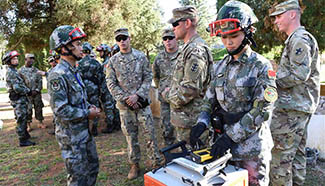SAN FRANCISCO, Nov. 16 (Xinhua) -- A research team at Stanford University has developed a tiny, ultra-low-energy wireless radio to facilitate what is known to be the Internet of Things (IoTs).
The IoT is a vision of a world where everything, from implantable biosensors and wearable devices to smart cars and smart home sensors, confers and collaborates wirelessly to make the world a more interconnected place.
And the new device, known as HitchHike, which is tasked to pass commands to and from the network to a myriad of devices, was described in a paper being presented at the Association for Computing Machinery's SenSys Conference on Wednesday.
"HitchHike is the first self-sufficient WiFi system that enables data transmission using just micro-watts of energy - almost zero," Zhang said. "Better yet, it can be used as-is with existing WiFi without modification or additional equipment. You can use it right now with a cell phone and your off-the-shelf WiFi router."
Noting that a small battery could drive HitchHike for a decade or more, and it has the potential to harvest energy from existing radio waves and use that electromagnetic energy, plucked from its surroundings, to power itself, perhaps indefinitely, the researchers said the device could be available to be incorporated into wireless devices in the next three to five years.
Named HitchHike for its clever design that hitchhikes on incoming radio waves from a smartphone or a laptop, it translates those incoming signals to its own message and retransmits its own data on a different WiFi channel.
Currently about the size of a postage stamp, the Hitchhike prototype is a processor and radio in one. With a range of up to 50 meters and able to transmit up to 300 kilobits per second, it could be a major steppingstone along the journey to the IoTs.
As a variation on what is known as a backscatter radio, Hitchhike is more a reflector than a radio, by bouncing WiFi signals back into the atmosphere. To work as a true radio, its designers developed what they call "code word translation" to produce a meaningful message of its own.
With processor capabilities, HitchHike is a translation device. It translates the incoming code words of a WiFi signal into its own data. If the incoming code word indicates a zero and HitchHike wants it to remain a zero, it passes that code word unaltered. If, however, it wants to change that zero to a one, or vice versa, it translates it to the alternate code word.
To avoid radio interference between the original signal and the new data stream coming from HitchHike, as both are transmitted at the same time, the new device shifts its new signal to another WiFi channel.
"HitchHike opens the doors for widespread deployment of low-power WiFi communication using widely available WiFi infrastructure and, for the first time, truly empower the Internet of Things," Zhang was quoted as saying in a news release from Stanford in northern California on the U.S. west coast.
The researchers said they can make HitchHike smaller, perhaps even smaller than a grain of rice for use in implanted bio-devices like a wireless heart rate sensor.










